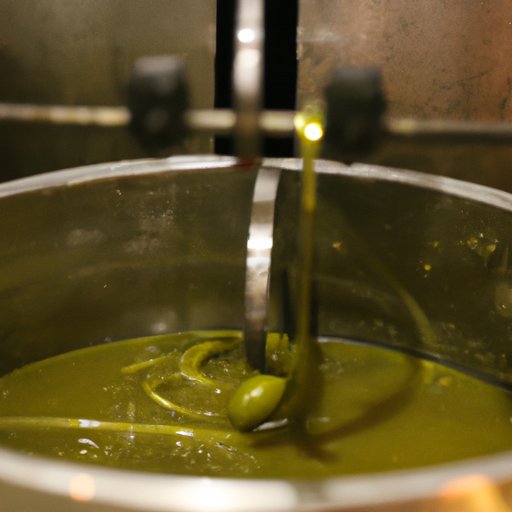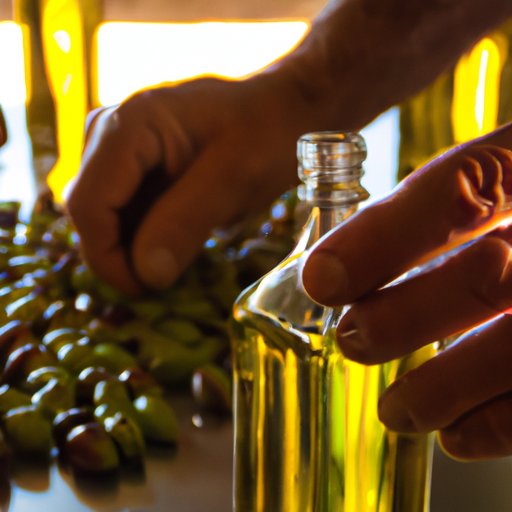
I. Introduction
Olive oil is a staple ingredient in Mediterranean cuisine renowned for its unique flavor and numerous health benefits. Its versatility and richness in monounsaturated fats, antioxidants, and anti-inflammatory properties make it an essential ingredient in cooking, skincare, and home remedies. With this step-by-step guide, you will learn how to make your own delicious liquid gold using traditional and modern methods. Let’s dive deep into the fascinating history, production process, and uses of olive oil.

II. History and Tradition of Olive Oil Production
Olive oil has been used for centuries by ancient civilizations such as the Greeks, Romans, and Egyptians. The first olive trees were believed to have been cultivated in the Mediterranean region over 5000 years ago. Throughout history, olive oil has played a significant role in cultural, religious, and economic affairs. In ancient Greece, athletes and warriors were anointed with olive oil as a symbol of victory and honor. In the Bible, olive oil was used for spiritual purification, anointing kings, and lighting holy lamps. Olive oil production has evolved over time, with modern technologies and sustainable practices enhancing the quality and quantity of this precious liquid.
III. Selecting the Best Olives for Olive Oil
Choosing the right type of olives is essential for making high-quality olive oil. The most popular olive varieties used in oil production include Arbequina, Hojiblanca, Picual, and Koroneiki. Each type has distinct characteristics in terms of color, flavor, and acidity. Selecting the best olives involves ensuring they are ripe, healthy, and free of defects. The best olives are handpicked, rather than harvested, to avoid damage to the fruit and preserve their taste.
IV. Exploring Different Methods of Extracting Olive Oil
There are two main methods for extracting olive oil: the traditional stone mill method and the modern centrifugation method. In the traditional stone mill method, the olives are crushed into a paste using a large stone wheel or millstone. The paste is then pressed to extract the oil. The modern centrifugation method involves separating the oil from the paste using a centrifuge machine. Both methods have their advantages and disadvantages in terms of yield, quality, and cost. The traditional method is labor-intensive and produces a lower yield but may result in a better quality oil. The centrifugation method is more efficient and produces a higher yield but may affect the oil’s flavor and aroma.
V. Step-by-Step Guide to Making Olive Oil
Making olive oil at home requires some specialized equipment and a bit of patience. Here’s a step-by-step guide to making your own liquid gold:
Equipment and tools required:
- Olives
- Olive oil press (or substitute with a blender or food processor)
- Muslin cloth or cheesecloth
- Containers for storing the oil
Harvesting and washing the olives:
Harvest ripe olives from your trees or purchase fresh olives from a local farmer. Discard any damaged olives and wash the remaining ones thoroughly with water.
Crushing and malaxation:
Crush the olives using a food processor or blender until they form a paste. You can also use a traditional stone mill. Let the paste sit for about 30 minutes to allow the oil to separate from the water and solids.
Separation and decantation:
Wrap the paste in a muslin or cheesecloth and place it in a press to extract the oil. Alternatively, you can place the paste in a bowl and pour hot water over it. The oil will float to the surface, and you can skim it off using a spoon. Let the oil sit for a few days to settle, then decant the oil into storage containers.
VI. Benefits and Uses of Olive Oil in Everyday Life
Olive oil is a versatile ingredient that has numerous health benefits and uses. Some of its benefits include lowering cholesterol, reducing inflammation, and promoting brain function. Some of its uses include:
- Cooking and baking – Use olive oil as a healthy alternative to butter or vegetable oil in cooking and baking recipes.
- Skincare – Use olive oil as a moisturizer, makeup remover, or hair conditioner.
- Home remedies – Use olive oil as a natural remedy for constipation, ear wax, or sore throat.
VII. Tips and Tricks for Enhancing the Flavor of Homemade Olive Oil
Once you’ve made your own olive oil, you may want to enhance its flavor by infusing it with herbs, spices, or fruits. Some tips for enhancing the flavor of homemade olive oil include:
- Use a high-quality olive oil to begin with, so the infusion will not overpower the original taste.
- Use fresh, organic herbs, spices, or fruits to maintain the quality of the oil.
- Store the oil in a dark, cool place to preserve the flavor and prevent spoilage.
VIII. The Future of Olive Oil Production and Sustainability Practices
Olive oil production faces several challenges, including pests and diseases, climate change, and water scarcity. To preserve this ancient tradition and ensure a sustainable future for olive oil production, it is essential to adopt sustainable practices such as:
- Conserving water resources by using drip irrigation, rainwater harvesting, and wastewater reuse.
- Protecting olive trees from pests and diseases by using natural predators, pheromone traps, and biological control.
- Reducing greenhouse gas emissions and promoting renewable energy sources for olive oil production and processing.
IX. Conclusion
In conclusion, olive oil is an ancient and beloved ingredient that has stood the test of time for its many health benefits and culinary uses. With a bit of know-how and the right tools, you can make your own liquid gold at home using traditional or modern methods. By choosing the best olives, understanding the extraction process, and incorporating sustainable practices, you can ensure a delicious and nutritious source of liquid gold for years to come.





